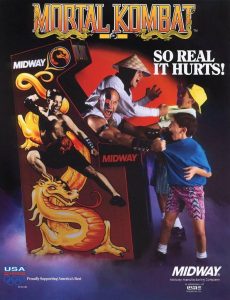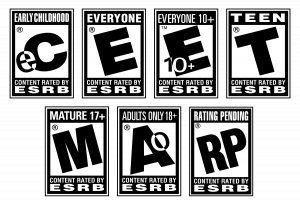Mortal Kombat: A Landmark Video Game, 30 Years On

This is a guest post from David Church, author of Mortal Kombat: Games of Death. This book is available in hardcover, paper, and open access! Start reading the book here.
Imagine: the year is 1992—October to be exact—the time of year when night and day alike take on an unmistakable chill, and horror movies begin flying off video rental shelves. A preteen boy walks into a shopping-mall arcade, his ears bombarded by a cacophony of electronic chirps and zaps while his eyes adjust to the dim, blue, overhead lighting. Despite the ‘No Smoking’ signs posted on the walls, the space smells of stale cigarettes and frustration. Most of the other patrons are teenagers—plus a few conspicuously older adult men—and the boy feels a twinge of excitement that he might blend in with this motley assemblage of anonymous older males. The boy saunters toward an imposing red-and-yellow cabinet positioned as an endcap on a back-to-back row of other, less populated cabinets. Given a place of pride, the game has drawn a small crowd of onlookers, their eyeballs fixated upon the glowing screen as a cloud of electronically modulated grunts, frantic button tapping, and the occasional human groan of annoyance from one of the two players perched before the screen all create an auditory bubble from which the other machines’ noises pale.
On the screen, two fighters alternately slink back and forth or somersault through the air to deliver well-timed kicks and punches to their respective opponent. Lit by a full moon overhead, they parry upon a perilously thin stone bridge suspended between two rocky crags. (For a brief moment, the tiny silhouette of a kite flies in front of the moon: a joke? A clue to something larger?) One is so easily drawn into the mysteries of this dark scene, wondering what lurks just beyond the edges of the frame—other than, of course, the three or four quarters lined up against the bottom edge of the beveled screen, a clear reminder of the flesh-and-blood world resting just beyond the unfolding carnage.
A shirtless, muscle-bound fighter has just fired a ball of orange energy from his hands with all the nonchalance of swatting a mosquito. His opponent, a ninja clad in a pale-blue uniform, dodges the projectile by sliding across the stone platform in a low crouching attack, knocking the other off his feet. After a few more blows, a stentorian voice shouts “Finish Him!” and the onlookers assembled around the cabinet brace for what they somehow know is coming: the losing opponent is about to be knocked clear of his tenuous footing and fall like dead weight onto a bed of long spikes far below, becoming just another addition to a grisly collection of impaled heads and corpses left to rot after past fights.
[embed]https://www.youtube.com/watch?v=7F82XAvCuVc[/embed]
And yet, something else happens: with an ominous chime, the screen goes dark and the ninja thrusts his arm toward the defeated fighter’s neck. With a motion that seems both smooth and unbelievably brutal, the ninja jerks the other man’s head from his shoulders. As a fountain of blood subsides, the ninja triumphantly holds the head aloft, its attached spinal column still dangling in the breeze. The small crowd of onlookers breathes a small sigh of resignation that the spectacular moment they expected to see has not transpired—but somehow they are not truly disappointed by this alternate gory attraction.
As the defeated player steps away from his joystick and another steps forward to claim a previously placed quarter from the bevel, the boy ventures to speak up, asking the victorious young man how he performed that climactic move. Perhaps the young man deigns to answer, quickly rattling off the combination (“Forward, Down, Forward, High Punch”)—or perhaps he just shrugs his shoulders and silently turns back to the screen, leaving the boy with the tantalizing possibility that perhaps he, too, could show off such an impressive spectacle of death….
It’s difficult to describe the sheer excitement that the early Mortal Kombat games evoked for kids of my generation without lapsing into self-indulgent nostalgia—but this Fall marks the thirtieth anniversary of Mortal Kombat (1992), an arcade game that helped propel the fighting genre into one of that decade’s biggest gaming trends, while also serving as a notorious benchmark for video game violence. Over the past three decades, the series has stood at the center of several major transitions in video game history: the creation of industry self-regulation standards, the convergence of cinema and video games, the popularization of 16-bit home consoles, the shift from 2D to 3D game engines, and several waves of industrial reorganization. Moving beyond fannish trivia and oft-told tales, Mortal Kombat: Games of Death explores this history by diving deep into the longer evolution of fighting games, the transnational web of kung-fu and wuxia movies that inspired Mortal Kombat ’s world, the various political controversies that the series has faced, and its rise and fall (and belated resurgence) as a pop-culture phenomenon.
[embed]https://www.youtube.com/watch?v=Z-e_JLbiG-0[/embed]
First developed by John Tobias and Ed Boon of Chicago-based Midway Games, Mortal Kombat had to somehow differentiate itself from Capcom’s smash success, Street Fighter II: The World Warrior (1991), a Japanese import whose inclusion of a large roster of playable characters—each with their own special moves and gameplay strategies—had set a new industry standard for fighting games. Unlike Capcom’s colorful but stereotypical characters (each one meant to represent a different country), however, Midway added something fresh to the fighting game: narrative depth. Inspired by films like Enter the Dragon (1973), Zu: Warriors from the Magic Mountain (1983), and Bloodsport (1988), Mortal Kombat gave unique backstories to each character competing in a mysterious, fight-to-the-death tournament with potentially world-ending stakes. Over its sequels, the Mortal Kombat series would expand this shadowy storyworld into an increasingly dense cosmology of warring deities, parallel dimensions, and overlapping timelines. Meanwhile, Midway enhanced the games’ overall air of mystery via the inclusion of hidden characters, secret moves, and other “Easter eggs” that turned arcades into hothouses of rumors.
Chief among these secrets were the so-called “finishing moves” that could be executed at the end of a match—including the notoriously gory “fatality” moves, a gimmick that became the first game’s most spectacular (and most imitated) feature. The series’ liberally applied splatterings of blood and gore seemed all the more realistic because, unlike Street Fighter II ’s cartoonish, anime-styled characters, Mortal Kombat ’s fighters were rendered through the process of “pixilation,” a stop-motion animation technique in which photographed still frames of live actors (martial artists filmed at Midway’s studios) create the illusion of lifelike movement. Although Midway was not alone in experimenting with pixilation, its refinement of the technique became another important market of product differentiation—as well as a trait that the series’ crude imitators, rushed to market at the height of the mid-1990s Mortal Kombat craze, would ape to far lesser effect.
[embed]https://www.youtube.com/watch?v=1AnggPF9Ta4[/embed]
But the series, though enormously popular at arcades, didn’t generate significant controversy until Mortal Kombat was first released to 16-bit home consoles—and thus brought under parents’ watchful eyes—in September 1993. Because home gaming consoles were typically considered a domestic toy meant for children, Nintendo maintained a “family-friendly” policy for games released on its NES and SNES systems, whereas SEGA was more willing to court an older teen audience. Thus, Mortal Kombat ’s blood and fatalities were censored on its SNES port, while the SEGA Genesis version hid the gore behind a not-so-secret “blood code.” Reviewers in gaming magazines then used this distinction as a referendum on not just Mortal Kombat ’s overall value (as compared to the largely bloodless Street Fighter II ), but also on the strengths of each recently introduced 16-bit console.
Several months later, U. S. Senators Joe Lieberman and Herbert Kohl convened Congressional hearings on video game violence, singling out Mortal Kombat , the rail-shooter Lethal Enforcers (1992), and the interactive-movie Night Trap (1992)—three games from different genres, released in close succession, and all united by their use of photorealistic violence. If Mortal Kombat ’s arrival on home consoles had spawned the Congressional hearings, then the one-year timeline that Congress imposed on the overall industry was deliberately intended to resolve the issue prior to Mortal Kombat II ’s (1993) home releases. Midway’s series thus served as the prime motivator for the Electronic Software Rating Board’s (ESRB) formation by September 1994—and therefore remains its most lasting legacy. Although this important piece of video game history has been told elsewhere, Mortal Kombat: Games of Death adds fresh perspective by examining the scandal’s coverage in major gaming magazines, the critical reception of Mortal Kombat ’s home ports, and the games’ persistent use in media-effects studies.
Moreover, the book continues the story of how Mortal Kombat ’s notoriety spawned a mid-1990s transmedia franchise, even as the games’ quick rise to popularity led to market oversaturation by family-friendly spinoffs and cheaply made knockoffs. Meanwhile, Midway found itself again lagging behind major genre developments seen in Japanese imports like Virtua Fighter (1993) and Tekken (1994), the first generation of 3D fighting games. By the turn of the millennium, the series still struggled to balance core gameplay pleasures with Midway’s more convoluted efforts at world-building and generic variation, especially as newer generations of home consoles usurped the coin-op market for fighting games.
[embed]https://www.youtube.com/watch?v=NYH2sLid0Zc[/embed]
Over the past decade, though, Mortal Kombat has been successfully rebooted—not just for a younger generation of gamers, but for a now-adult generation no longer purportedly in need of protection from violent content. As well as returning to many of the generic traits that made the original games so enthralling, the series continues to permeate pop culture—such as the eponymous 2021 live-action film, a testament to the series’ legacy of uniting video games and cinematic aesthetics. Thirty years after its debut, Mortal Kombat ’s initial notoriety may now be muted, but as Mortal Kombat: Games of Death explains, its influence across the media landscape lives on.




